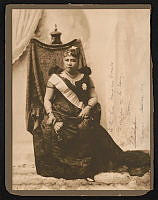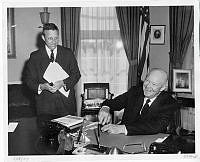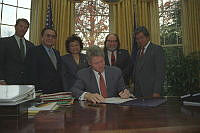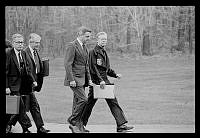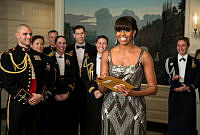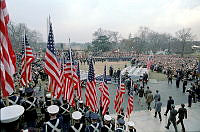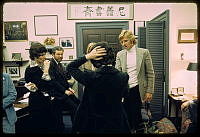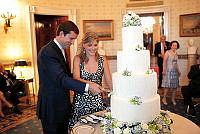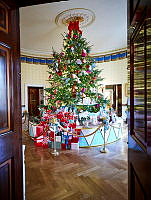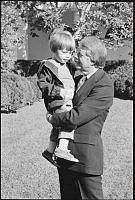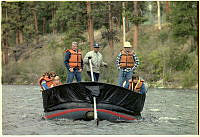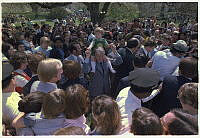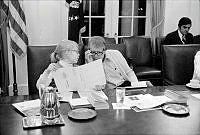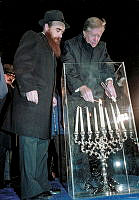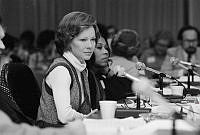A Presidential Funeral
Copyright © White House Historical Association. All rights reserved under international copyright conventions. No part of this article may be reproduced or utilized in any form or by any means, electronic or mechanical, including photocopying, recording, or by any information storage and retrieval system, without permission in writing from the publisher. Requests for reprint permissions should be addressed to books@whha.org
Flags lowered. A flag-draped coffin. A stoic first lady on the arm of a military aide. The fly over of twenty one fighter aircraft. Gunfire salutes at military installations across the country. These are the familiar sights and sounds of a state funeral for a modern day American president. With the ceremonies attendant to the passing of President Ford fresh in mind, it is timely to reexamine the funeral proceedings that sear the final images of a president into the consciousness of the American public.
The nation has witnessed the deaths of just four presidents over the past three decades, and only three of those chose to have state funerals—Lyndon B. Johnson (1973), Ronald Reagan (2004), and Gerald R. Ford (2007). Although Richard Nixon’s family had the option of a state funeral, they decided instead to hold a simple service at the Nixon Library and Birthplace in California, where in 1994 President Nixon, the first president to resign from office, was buried beside his wife, Patricia Nixon, who predeceased him. Traditionally five days in length, presidential state funerals are meticulously choreographed. Coordination for the events is conducted by the army’s Military District of Washington and begins early in each presidential term, when a new president is asked to attend to the strange task of imagining his own funeral service. It is a cold realization that greets a new president at the White House door.
By helping plan their own funeral, presidents are able to incorporate personal touches that can elucidate their character and legacy on a national stage for the last time. In many ways, funeral services are final conversation with the nation, and illustrate something about the man and the way in which he wishes to be remembered. We recently observed this following the death in the funeral of President Ford. Tailored to fit his particular persona, the services and events surrounding the five days of remembrance departed from tradition and provided Americans a glimpse at the complexion of the man who served the nation in multiple capacities, including the presidency, over his lengthy career.
In both what he elected to include in his services and what he chose to leave out, President Ford painted in symbols the portrait of his public life. For example, he determined to lie in state in front of both the House and Senate chambers in the Capitol to honor and highlight his service in each. “I know personally how much those two tributes themselves meant to President Ford,” remarked Gregory D. Willard, a Ford family representative during a news conference at the time. In contrast, President Ford did not want his body to be borne along Pennsylvania Avenue to the Capitol by the horse-drawn caisson, traditional in so many presidential funerals.
Instead he requested a motorcade that passed through Alexandria, Virginia, hometown while he was in public service and went by the World War II Memorial on the National Mall, to pay tribute to his military service and an entire generation of fellow Americans who brought victory in that conflict.
An unassuming President Ford had to be persuaded to include many of the ceremonial formalities attached to state funerals. “The folks that handle protocol for the country worked with him to help him understand that the service was for the nation as well as for his family, and he agreed reluctantly to certain elements,” said the Reverend Robert Certain of St. Margaret’s Episcopal Church in Palm Desert, California, where President and Mrs. Ford worshipped. During his last symbolic journey to Washington, Ford’s body lay in state in the Capitol rotunda and this may remain as one of the most memorable and poignant images. In a proclamation announcing his death, President Bush characterized Ford as “a true gentleman who reflected the best in America’s character.” In an unprecedented and extraordinary act, Ford’s children greeted mourners and well-wishers personally as thousands streamed through the Capitol, paying their respects to the late president.
Upon arrival at the rotunda, President Ford’s flag-draped coffin was placed on the same bier originally constructed for Abraham Lincoln 142 years ago by government carpenters and used in the funerals of ten subsequent presidents. This connection to the past underscores the importance of tradition in honoring a president as one in a distinguished line. In the nineteenth century, while news of a presidential death carried the same significance it does today, information traveled by telegraph, not twenty-four hour cable news, and there was no pre-set form for official mourning.
Traditions for presidential funerals found models in royal funerals and Washington merchants Alexander Hunter and Darius Clagett staged the first, that of William Henry Harrison, in 1841. This funeral was held in the East Room at the White House, the mirrors and chandeliers elaborately draped in black crape. Following the service the lead-lined mahogany coffin was mounted on a splendid “funeral car” or float, and drawn by black draped horses to the Congressional Cemetery for temporary burial until winter ice melted and it would be taken to Ohio for burial. Great numbers of pallbearers and dignitaries marched in the procession to dirges played by the Marine Band, punctuated by artillery salutes. Nineteenth century presidential funerals followed this pattern somewhat, Lincoln’s being even more elaborate and including a funeral train and “viewings” in city halls and state capitols from the East Coast to the final resting place in Springfield, Illinois.
Sorrowful grandeur of this sort faded with the twentieth century, still the flavor of presidential mourning remained highly ceremonial. The first president to die in the twentieth century was William McKinley, assassinated in September 1901. Decorations of mourning for him were greatly simplified from what had taken place for President Garfield twenty years before. His body lay in state in the Capitol. Likewise Warren G. Harding’s funeral ornaments were even simpler. First he lay in state in the East Room, but his official funeral service took place in the Capitol rotunda, where the public was admitted to view the coffin adorned with a flag and eagle made of flowers in red, white and blue, designed by his widow Florence Harding, hence a personal touch.
Funerals of Presidents Franklin D. Roosevelt and John F. Kennedy continued the trend for subtle, yet distinct mourning decorations. Both, like Harding, having died in office, they first lay in state in the East Room, where trim black drapery dimmed the festive sparkle of the chandeliers. The coffins stood on the Lincoln bier, flag-draped with a limited surrounding of flowers. After a day, usually, the procession began to the Capitol for the public lying in state prior to the religious service. The general pattern of the presidential funerals have thus been established for the better part of a century.
Upon President Ford’s passing, his official portrait hanging in the White House was draped simply in black, with white roses placed on a table beneath it. Immediately the mechanisms established long in advance were put into operation and the five day obsequies unfolded.













